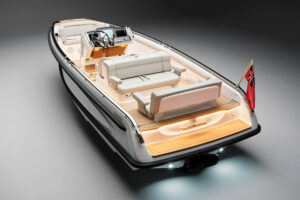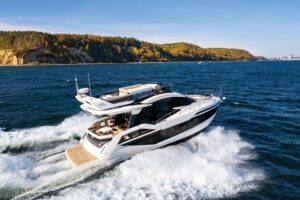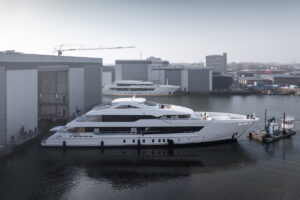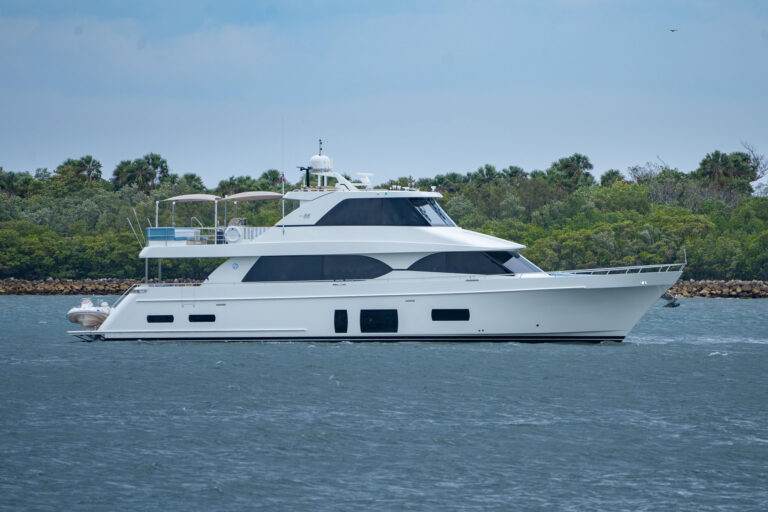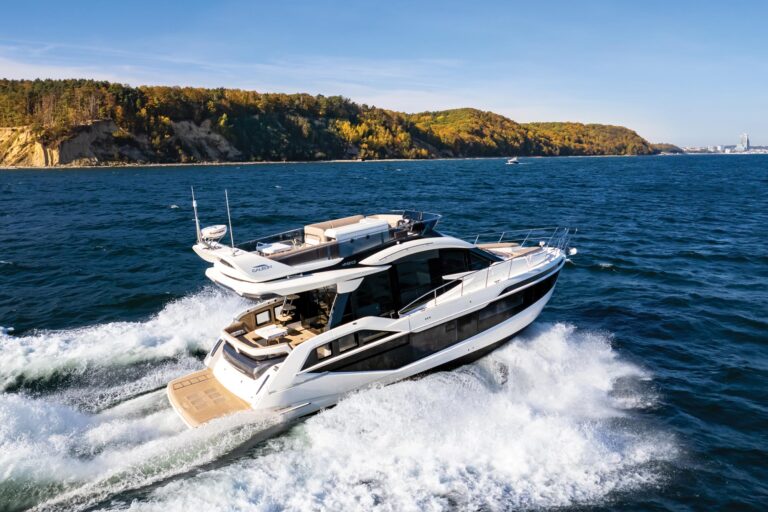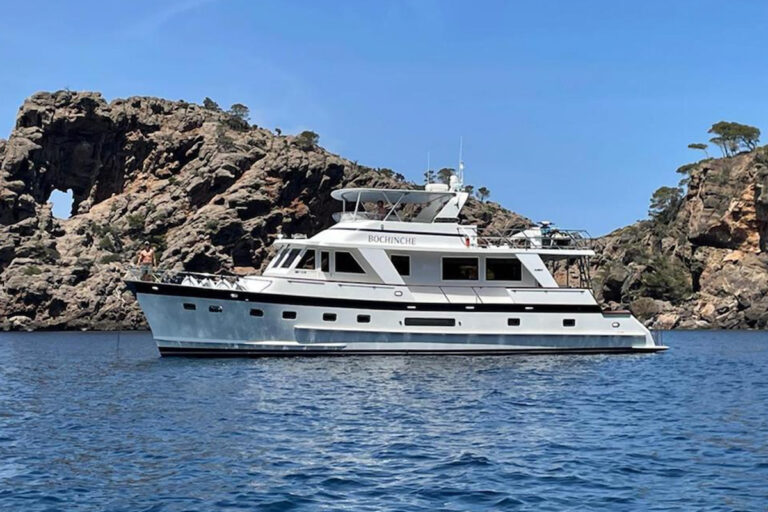I have been a fan of Burger Boat Company since I saw my first Burger motoryacht 40 years ago. Since then, the company has had its ups and downs, however, after almost a decade in the capable hands of David Ross and Jim Ruffolo, it’s as fit as a fiddle. I offer as evidence Wimil, the new Burger 90 Raised Pilothouse Motor Yacht. While her heritage and pedigree are without question, she is the product of a new Burger Boat Company that is focused on the future.
“Wimil is the first boat that we have had a totally free hand in since we reorganized the yard in 1993, said David Ross, who found it something of a compliment that a former Burger owner bought the yacht. “The gentleman visited the yard, inspected the boat and wrote a check.
This approach to new construction sales, which Ross calls Advanced Construction Series, is one he hopes to repeat. Starting boats on spec is nothing new for yards fortunate enough to have the necessary resources. It is an efficient method that allows builders more control over design and construction and, in turn, cost and profit.
However, Ross sees ACS as far more than a means of controlling costs. “Instead of starting with a basic specification and hoping to sell a more refined boat in the course of construction, we see ACS as a platform to showcase our craftsmen’s skills,” he said.
ACS projects are not for sale until they are complete-including everything from stabilizers to crystal stemware. When starting from scratch, designers and builders must deal not only with basic naval architecture, they must illustrate the details of a design. A program like ACS should appeal to buyers who do not want to sort through specifications, or who have trouble visualizing concepts.
“Customers can walk through the boat and make their judgment,” Ross said.
Burger’s CAD-equipped design team numbers 14, and Wimil was one of the three boats that is typically in their charge in the course of a year. This robust investment in engineering is something of a revolution, as builders of Henry Burger’s vintage did not think much of designers, and independent project management had not yet been invented.
“Our boats are far more complicated than they were when I joined the company in the early 1980s,” said Don O’Keeffe, Burger’s designer, who can recall working overtime in a design department of five to keep up with construction. Drawings were rarely completed before the boat. “Every boat was a bit different, but a nightstand was a nightstand and the joiner shop didn’t need a drawing to build one.” Today, the “yard standard” is far more flexible. Wimil is the product of more than 4,750 hours of design and engineering.
The effort shows. While O’Keeffe sculpted Wimil‘s crisp, contemporary silhouette, Douglas Richey, Burger’s in-house interior designer, developed her arrangement plan and specified her décor. Her handpicked recessed panel makore joinery is a far cry from the simple mahogany and ash interiors Henry Burger favored. Still, I suspect he would have approved of Wimil‘s classically styled joiner details and contemporary accents. It’s some of the finest work I have seen from the yard.
Wimil‘s main deck interior spaces are accessible from the side decks (port and starboard) and from the afterdeck. I am pleased that Burger did not succumb to competitive pressure and choose a full-beam saloon layout. In my view, side decks on this class of yacht are a necessity. Access to the bridge deck control station and adjacent public area is from the pilothouse. A saloon and formal dining area are abaft the raised pilothouse, while an open island-style galley with informal seating is forward. Stairs in the saloon lead below to a foyer that in turn leads to a full-beam master suite and two guest staterooms.
Stairs in the galley area lead below to the crew accommodations forward-an arrangement I prefer to positioning the crew abaft the engineroom, as has become popular. Some designers have forgotten that the guy paying for the boat deserves the spot in the hull with the most volume and the least motion.
Space abaft the engineroom is accessible from the swim platform and serves as a utility room and water-sports stowage area. The engineroom is also accessible from the main deck. Wimil‘s machinery and systems installation appear to be in keeping with the highest yacht standard.
Burger’s longevity is in part due to its ability to adapt. It was one of the first American yards to make the transition from wood construction to metal-first building boats in steel, then aluminum. Initially, most yacht builders designed metal structures as they had wood, using transverse framing systems. Modern longitudinal framing systems such as Wimil‘s are strong and far easier to shape, and they require less fairing material. Burger has been using this method since the 1980s and has mastered it. Wimil‘s Awlgrip finish is first class.
The yacht’s shell plating is welded to closely spaced bulb-T longitudinals that are welded to notched, deep transverse members positioned on 32-inch centers. A 5/16-inch shell plating is used on the bottom, with heavier 3/8-inch plate used in way of the machinery space and running gear. The hull sides are fabricated with quarter-inch shell plating. Fuel is carried in integral tankage that forms a double bottom for most of the boat’s length.
One of O’Keeffe’s first tasks when he arrived at Burger was to re-engineer the yard’s hull form. “These designs by Olin Stephens, Jack Hargrave and Weston Farmer were wonderful, he said, but the hulls were intended for cruising speeds of 14 to 15 knots. “Folks wanted to go faster, and larger engines became a significant percentage of a design’s overall weight. It was time for change. O’Keeffe prescribed a hard chine semi-displacement form with a bit less keel and a bit more deadrise aft. Instead of positioning the engines forward of the accommodation space, he moved them aft. This optimized weight distribution for cruising speeds in the 20-knot range. According to Burger, Wimil cruises at 19 knots with owner’s gear aboard.
While Burger’s mainstay is still custom building, Ross said he thinks ACS projects like Wimil will become increasingly popular. He hopes to offer one a year.
“We are so proud of this project,” he said. “Every craftsman at Burger contributed something special to the effort.”
The investment paid off. Wimil and ACS are a fine complement to Burger’s 140-year-old pedigree.
Contact: Burger Boat Co., (920) 684-1600; www.burgerboat.com.

